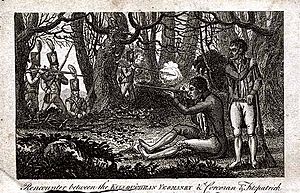James Corcoran facts for kids
James Corcoran (born around 1780 – died 1804) was an Irish rebel leader. After the big rebellion of 1798 ended, he continued to fight against the British forces. He led a small group of fighters in Wexford and Kilkenny until he was defeated and died in 1804.
Corcoran's Rebel Activities
James Corcoran was an important part of the 1798 rebellion. He led a group of rebels at the Battle of New Ross. After the rebellion was put down, he and other survivors hid in Killaughrim Woods. This area is in northern County Wexford. From here, they would launch surprise attacks in Wexford and County Carlow.
In August 1801, Corcoran and his men became more active. The government in Dublin Castle called them "dangerous." They sent 200 soldiers to find and stop the group. But the soldiers had little success. Local people helped to hide Corcoran's men from the army.
Fighting the British Forces
Corcoran's group was known for letting soldiers who left the army join them. They also tried to get weapons from soldiers living among the people. In June 1802, near Mount Leinster, they showed how brave they were. They turned around and attacked some soldiers from Newtownbarry who were chasing them. Corcoran's men won the fight and chased the soldiers instead.
In July 1803, another rebellion led by Robert Emmet failed. This made the British even more determined to stop all rebel activity in Ireland. A new plan was started to capture Corcoran. The British knew that Corcoran's men had support from the local people. They also knew the rebels hid in faraway places. So, the government started arresting people who helped the rebels. They also planned to build new roads and army camps. These would cover the area between Mount Leinster and the Blackstair mountains.
Defeat and Death
By the start of 1804, Michael Dwyer had surrendered in December 1803. This meant Corcoran and his men were the only rebel group still fighting in Ireland. The army's efforts forced Corcoran to move to southern Kilkenny. From there, he continued his operations. He angered the government by attacking mail coaches.
A reward of £500 was offered for Corcoran. This pressure made him split his group into smaller teams. He then returned to his old base in Killaughrim Woods, near Enniscorthy. The end came on February 11, 1804. The reward led an informer to tell the army where Corcoran was. Corcoran and his last few comrades were surrounded by soldiers in Killaughrim Woods. They fought hard, but all of them were killed or captured. Corcoran died from his wounds shortly after the fighting. His body and the bodies of his comrades were taken to Wexford. They were hung outside the town jail for people to see for a while.
Sources


